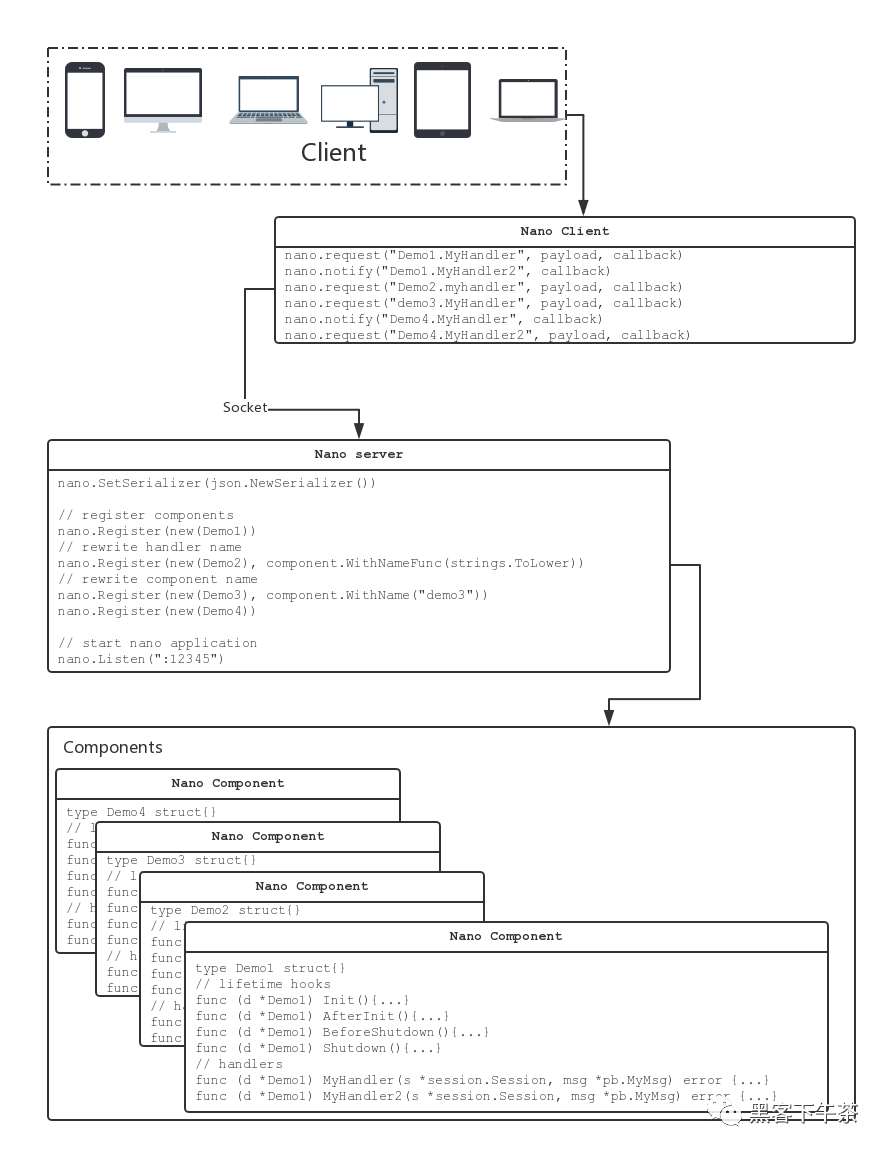- 1github慢_github 慢
- 2AI自然语言处理NLP原理与Python实战:22. NLP项目实践与案例分析_自然语言处理nlp实训项目python
- 3Small-Footprint Open-Vocabulary Keyword Spotting with Quantized LSTM Networks
- 4白话sql注入(sql Injection)系统总结
- 5(转)人工智能步入金融领域的主流玩法
- 6MySQL 时间入库问题:Incorrect datetime value: '' for column 'createTime' at row 1_incorrect datetime value: '2023-02-30' for column
- 7第二篇【传奇开心果微博系列】Python微项目技术点案例示例:成语接龙游戏_py实现成语接龙
- 8【文献阅读笔记】之基于Deeplabv3+的图像语义分割优化方法_基于改进deeplabv3+网络的马铃薯根系图像分割方法
- 9hnu 数字电路 实验2.4 4位先行进位加法器
- 10【PTA 5-10 树的遍历 (25分)】+ 二叉树_pta西南石油大学二叉树遍历
golang 框架_探索 Golang 云原生游戏服务器开发,5 分钟上手 Nano 游戏服务器框架...
赞
踩

介绍
Nano 是什么?
轻量级,方便,高性能 golang 的游戏服务器框架。
nano 是一个轻量级的服务器框架,它最适合的应用领域是网页游戏、社交游戏、移动游戏的服务端。当然还不仅仅是游戏,用 nano 开发高实时 web 应用也非常合适。
最重要的是可以通过这个入门 Golang 游戏服务器框架开发
示例仓库
[cloud-native-game-server](https://github.com/Hacker-Linner/cloud-native-game-server)
使用 Nano 快速搭建一个 Chat Room
一句话描述 Nano 术语
组件(
Component):nano应用的功能就是由一些松散耦合的Component组成的,每个Component完成一些功能。Handler:它定义在Component内的方法,用来处理具体的业务逻辑。路由(
Route):用来标识一个具体服务或者客户端接受服务端推送消息的位置。会话(
Session):客户端连接服务器后, 建立一个会话保存连接期间一些上下文信息。连接断开后释放。组(
Group):Group可以看作是一个Session的容器,主要用于需要广播推送消息的场景。请求(
Request), 响应(Response), 通知(Notify), 推送(Push):Nano中四种消息类型。
组件的生命周期
type DemoComponent struct{}func (c *DemoComponent) Init() {}func (c *DemoComponent) AfterInit() {}func (c *DemoComponent) BeforeShutdown() {}func (c *DemoComponent) Shutdown() {}Init:组件初始化时将被调用。
AfterInit:组件初始化完成后将被调用。
BeforeShutdown:组件销毁之前将被调用。
Shutdown:组件销毁时将被调用。
整个组件的生命周期看起来非常的清晰。
一句话描述业务
用户可以加入具体房间
用户可以看到房间内所有成员
用户可以在当前房间发送消息
业务具体分析
用户可以加入具体房间
请求加入(
Request) ->Request对应nano一种消息类型需要响应(
Response)是否允许加入 ->Response对应nano一种消息类型
用户可以看到房间内所有成员
服务端主动推送(
Push)房间内所有成员Members->Push对应nano一种消息类型服务端主动广播?(
Push)房间内其它成员,有新人加入New user
用户可以在当前房间发送消息
用户发送(
Notify)消息到当前房间 ->Notify对应nano一种消息类型,不需要服务器对他有所回应服务器将消息?(
Push)给房间其它成员
至此,我们了解了业务,然后通过业务我们又了解了 Nano 的四种消息类型应用。
Demo 源码解析
demo/1-nano-chat
type (// 房间的定义 Room struct {// 管理房间内所有的会话 group *nano.Group }// RoomManager 表示一个包含一堆房间的组件,他是 nano 组件,可在生命周期内 hook 逻辑 RoomManager struct {// 继承 nano 组件,拥有完整的生命周期 component.Base// 组件初始化完成后,做一些定时任务 timer *scheduler.Timer// 多个房间,key-value 存储 rooms map[int]*Room }// 表示一个用户发送的消息定义 UserMessage struct { Name string `json:"name"` Content string `json:"content"` }// 当新用户加入房间时将收到新用户消息(广播) NewUser struct { Content string `json:"content"` }// 包含所有成员的 UID AllMembers struct { Members []int64 `json:"members"` }// 表示加入房间服务端的响应结果 JoinResponse struct { Code int `json:"code"` Result string `json:"result"` }// 流量统计 Stats struct {// 继承 nano 组件,拥有完整的生命周期 component.Base// 组件初始化完成后,做一些定时任务 timer *scheduler.Timer// 出口流量统计 outboundBytes int// 入口流量统计 inboundBytes int })// 统计出口流量,会定义到 nano 的 pipelinefunc (stats *Stats) outbound(s *session.Session, msg *pipeline.Message) error { stats.outboundBytes += len(msg.Data)return nil}// 统计入口流量,会定义到 nano 的 pipelinefunc (stats *Stats) inbound(s *session.Session, msg *pipeline.Message) error { stats.inboundBytes += len(msg.Data)return nil}// 组件初始化完成后,会调用// 每分钟会打印下出口与入口的流量func (stats *Stats) AfterInit() { stats.timer = scheduler.NewTimer(time.Minute, func() {println("OutboundBytes", stats.outboundBytes)println("InboundBytes", stats.outboundBytes) })}func (st *Stats) Nil(s *session.Session, msg []byte) error {return nil}const (// 测试房间 id testRoomID = 1// 测试房间 key roomIDKey = "ROOM_ID")// 初始化 RoomManagerfunc NewRoomManager() *RoomManager {return &RoomManager{ rooms: map[int]*Room{}, }}// RoomManager 初始化完成后将被调用func (mgr *RoomManager) AfterInit() {// 用户断开连接后将会被调用// 将它从房间中移除 session.Lifetime.OnClosed(func(s *session.Session) {if !s.HasKey(roomIDKey) {return } room := s.Value(roomIDKey).(*Room)// 移除这个会话 room.group.Leave(s) })// 一个定时任务,每分钟打印下房间的成员数量 mgr.timer = scheduler.NewTimer(time.Minute, func() {for roomId, room := range mgr.rooms {println(fmt.Sprintf("UserCount: RoomID=%d, Time=%s, Count=%d", roomId, time.Now().String(), room.group.Count())) } })}// 加入房间的业务逻辑处理func (mgr *RoomManager) Join(s *session.Session, msg []byte) error {// 注意:这里 demo 仅仅只是加入 testRoomID room, found := mgr.rooms[testRoomID]if !found { room = &Room{ group: nano.NewGroup(fmt.Sprintf("room-%d", testRoomID)), } mgr.rooms[testRoomID] = room } fakeUID := s.ID() // 这里仅仅是用 sessionId 模拟下 uid s.Bind(fakeUID) // 绑定 uid 到 session s.Set(roomIDKey, room) // 设置一下当前 session 关联到的房间// 推送房间所有成员到当前的 session s.Push("onMembers", &AllMembers{Members: room.group.Members()})// 广播房间内其它成员,有新人加入 room.group.Broadcast("onNewUser", &NewUser{Content: fmt.Sprintf("New user: %d", s.ID())})// 将 session 加入到房间 group 统一管理 room.group.Add(s)// 回应当前用户加入成功return s.Response(&JoinResponse{Result: "success"})}// 同步最新的消息给房间内所有成员func (mgr *RoomManager) Message(s *session.Session, msg *UserMessage) error {if !s.HasKey(roomIDKey) {return fmt.Errorf("not join room yet") } room := s.Value(roomIDKey).(*Room)// 广播return room.group.Broadcast("onMessage", msg)}func main() {// 新建组件容器实例 components := &component.Components{}// 注册组件 components.Register(// 组件实例 NewRoomManager(),// 重写组件名字 component.WithName("room"),// 重写组件 handler 名字,这里是小写 component.WithNameFunc(strings.ToLower), )// 流量统计 pip := pipeline.New()var stats = &stats{}// 入队 Outbound pipeline pip.Outbound().PushBack(stats.outbound)// 入队 Inbound pipeline pip.Inbound().PushBack(stats.inbound)// 注册下流量统计组件 components.Register(stats, component.WithName("stats"))// 设置日志打印格式 log.SetFlags(log.LstdFlags | log.Llongfile)// web 静态资源处理 http.Handle("/web/", http.StripPrefix("/web/", http.FileServer(http.Dir("web"))))// 启动 nano nano.Listen(":3250", // 端口号 nano.WithIsWebsocket(true), // 是否使用 websocket nano.WithPipeline(pip), // 是否使用 pipeline nano.WithCheckOriginFunc(func(_ *http.Request) bool { return true }), // 允许跨域 nano.WithWSPath("/nano"), // websocket 连接地址 nano.WithDebugMode(), // 开启 debug 模式 nano.WithSerializer(json.NewSerializer()), // 使用 json 序列化器 nano.WithComponents(components), // 加载组件 )}前端代码非常简单,大家直接看 cloud-native-game-server
Docker 搭建开发调试环境
Dockerfile
Dockerfile.dev
FROM golang:1.14WORKDIR /workspace# 阿里云RUN go env -w GO111MODULE=onRUN go env -w GOPROXY=https://mirrors.aliyun.com/goproxy/,direct# debugRUN go get github.com/go-delve/delve/cmd/dlv# live reloadRUN go get -u github.com/cosmtrek/air# nanoRUN go mod init cloud-native-game-serverRUN go get github.com/lonng/nano@master构建 Image:
docker build -f Dockerfile.dev -t cloud-native-game-server:dev .docker-compose.yaml
version: "3.4"services:demo:image: cloud-native-game-server:devcommand: > bash -c "cp ./go.mod ./go.sum app/ && cd app/demo/${DEMO} && ls -la && air -c ../../.air.toml -d" volumes:- ./:/workspace/appports:- 3250:3250demo-debug:image: cloud-native-game-server:devcommand: > bash -c "cp ./go.mod ./go.sum app/ && cd app/demo/${DEMO} && ls -la && dlv debug main.go --headless --log -l 0.0.0.0:2345 --api-version=2" volumes:- ./:/workspace/appports:- 3250:3250- 2345:2345security_opt:- "seccomp:unconfined"启动开发环境(支持 live reload)
# 如我要开发 1-nano-chatDEMO=1-nano-chat docker-compose up demo进入 localhost:3250/web/ 可以看到效果。
启动调式环境
# 如我要调试 1-nano-chatDEMO=1-nano-chat docker-compose up demo-debug


